Spice: Uncontrolled substance killing residents, dividing communities
LAS CRUCES – TO MANY IN LAW ENFORCEMENT, IT SEEMS IMPOSSIBLE — LIKE ROLLING A BOULDER UP A MOUNTAIN.
Damien Willis, Las Cruces Sun-News LAS CRUCES -
Too many in law enforcement, it seems like an impossible problem to tackle — like rolling a boulder up a mountain. And the idea of legislating a solution is bleak.
Las Cruces, like the rest of the nation, has seen a rise in the use of synthetic drugs in recent years. Synthetic cannabinoids, commonly referred to as Spice or K2, dates to 1984, when John William Hoffman, a Stanford University organic chemist, developed 450 synthetic cannabinoid compounds that mimic the effects of marijuana by similarly targeting endocannabinoid receptors.
In the late 2000s, two of those compounds began being marketed and sold as legal marijuana alternatives, known as K2 and Spice. In the years since, those name brands have become genericized and are often used to refer to synthetic cannabinoids more broadly.
High overdose risk
Because Spice is often marketed as “herbal incense,” in packets marked “not for human consumption,” it is not regulated by the Federal Drug Administration or the U.S. Department of Agriculture. The product — typically a benign leafy organic, like coltsfoot, damiana or mugwort, sprayed or doused in chemicals including the synthetic cannabinoid — varies widely in potency between products and batches. For these reasons, the risk of overdosing is high.Symptoms of overdose include increased agitation, muscle spasms, increased heart rate or decreased alertness. People using Spice can also experience general excitability, psychosis or suicidal thoughts. Long-term use can lead to heart and kidney failure, diminished brain function and cognitive decline.
Local emergency rooms continue to see Spice overdoses, though not at the same level as October, when it peaked, according to officials at MountainView Regional Medical Center.
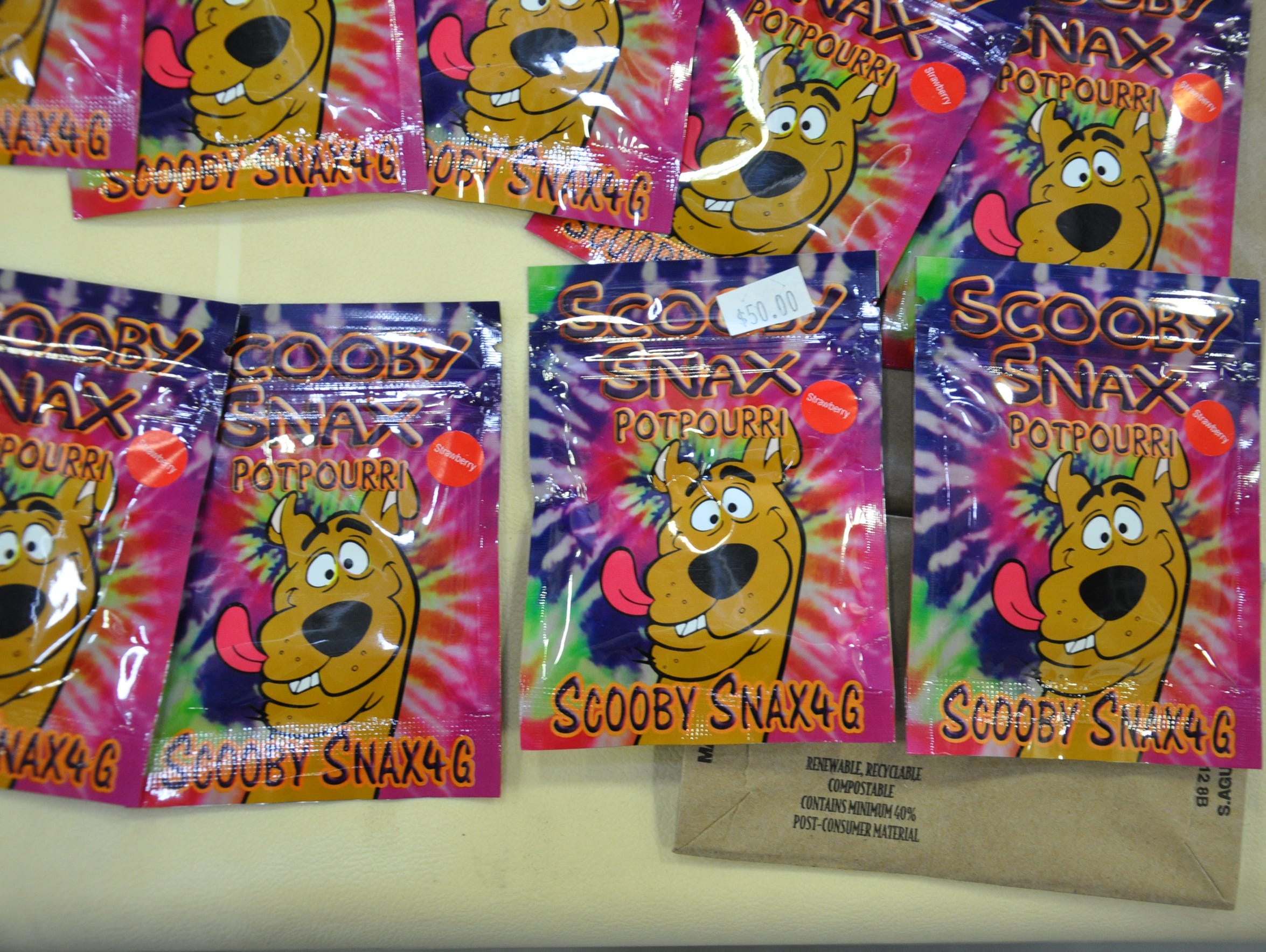
Packets advertising Scooby Snax contain the drug spice.
(Photo: Courtesy DEA- El Paso Division)
Cheap and easy to get
“This is definitely something that we continue to deal with,” said Matt Mercer, an outreach coordinator and case manager at Mesilla Valley Community of Hope. Because of the drug’s low cost and high availability, the Spice epidemic has hit the city’s homeless population particularly hard. Mercer believes the decline in overdoses may be because of the colder weather, and said he believes the number will begin picking up when temperatures rise.
“With our clients, we typically see substance abuse going in cycles,” Mercer said. “We’ll see a cycle of meth, a cycle of heroin — but the Spice is always there. It doesn’t go away. Because it’s so cheap, and so readily available. Spice is always there, even when the money has all but run out.”
Illegal drugs, including Spice, are banned on the Community of Hope campus, where most of the city’s services for the homeless are located. Nevertheless, Spice is a problem staff and volunteers deal with regularly.
“The homeless community here has never seen anything like this,” Mercer said. “To see two dozen people over the last few years either die, or be constantly OD’ing — all of the chaos and violence — everyone is on edge.”
Mercer said, because the drug can make users so volatile and erratic, the drug has taken on a stigma, and is not tolerated by non-users in the homeless community.
“With other drugs — whether they are illicit or not — the homeless will generally look the other way. But Spice has caused a real rift in the community,” he said. “The residents and clients just won’t tolerate it — largely because they don’t know what kind of person they’ll be dealing with in the next 10 minutes.”
One Spice-related instance, he said, really stuck in everyone’s mind.
“There was a poor guy on Spice, crawling behind the daycare center, literally smashing his fingers into the pavement,” Mercer said. “He broke all of his fingers, all of his toes — sitting behind the daycare center, howling like a dog, covered in blood. You know, it’s so traumatic to see that. And I think it scares them. When people on Spice melt down, they MELT DOWN. It’s like ‘The Exorcist.’”
Former addict
“Spice sent me to the hospital five times,” said Andrea Broekhoff, a former Spice addict. “I started using it because I wanted to quit smoking weed. I was looking for a safe and legal alternative to weed. I have alcoholics in my family, but I sell myself as someone who knows better.”
At first it was fun, she said. Everything seemed okay.
“Then I started spacing out and losing time. My boyfriend would come into the room, and I would just be sitting there with my mouth open,” Broekhoff said. “He’d call me ‘Drooly Julie.’”
Her boyfriend, Bryan Roberts, said he didn’t know what to do with her.
“I’d get home, and she’d be like a shell sitting there, looking off into space,” Roberts said. “She’d pass out in the middle of a sentence.”
Though Roberts never smoked it, before he knew it, he was going to the smoke shop three or four times a week for his girlfriend.
“It’s deceptively cheap. It doesn’t cost much to buy it, but you end up smoking so much of it, because it’s so addictive,” he said. “The people at the smoke shops, the customers — you could tell how long they’d been doing it, just by looking at them. I wish that no one would ever have to go through this.”
Meanwhile, she was smoking Spice five times a day.
“It was the most expensive drug habit I ever had — far more expensive than weed, and it was draining our resources. It was costing us tons of money.”
Often, Broekhoff would get up early to hit the smoke shop, desperately in need of her morning fix. And she wasn’t alone.
“The smoke shop would open at 9 a.m. I’d get there at 8:30, and there’d be a line. The thing about Spice is, once you start it, weed doesn’t work for you anymore. Spice attaches to your THC receptors, so that weed just isn’t the same anymore.”
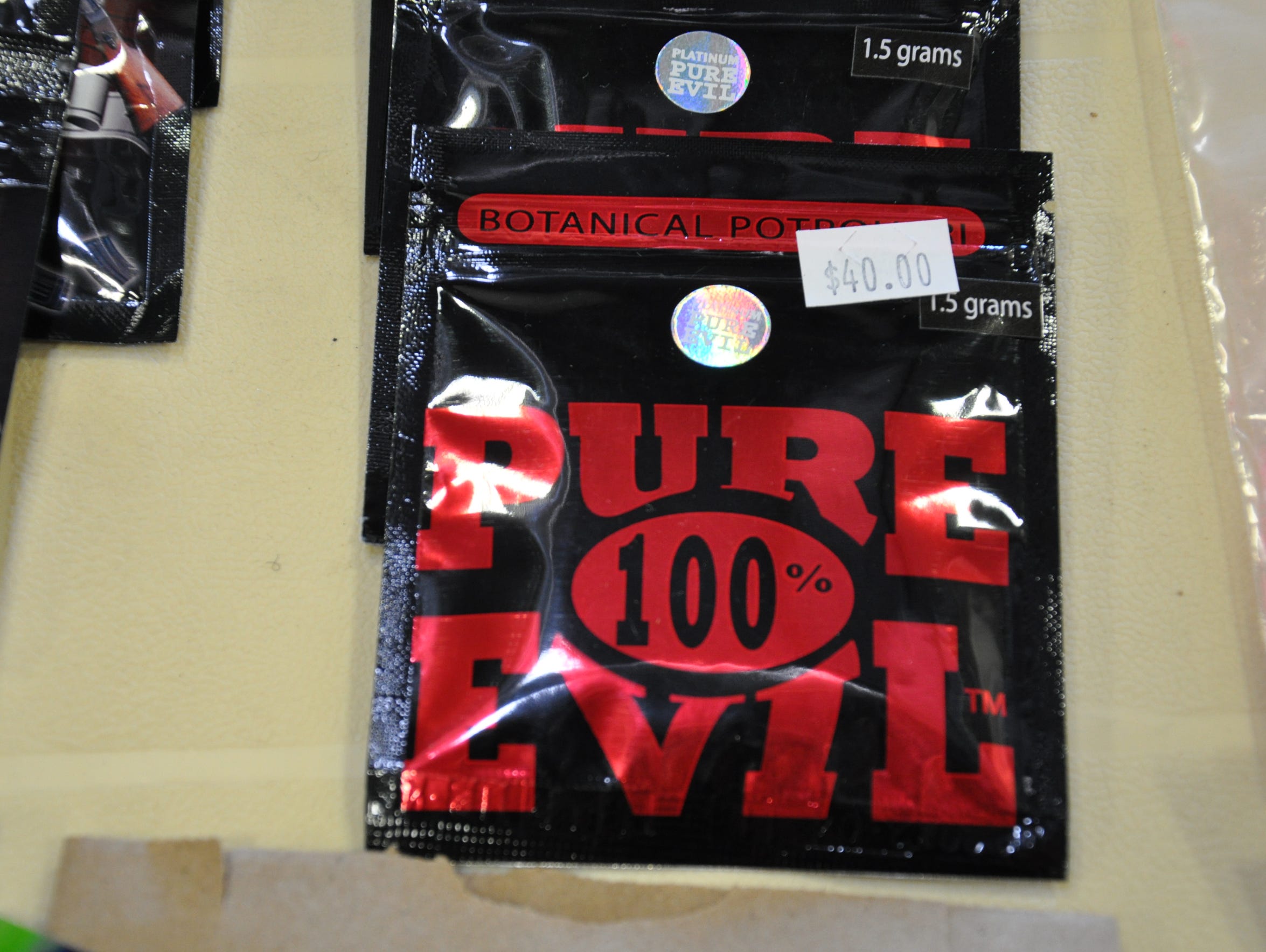
Packets advertising Pure Evil contain the drug spice.
(Photo: Courtesy DEA - El Paso Division)
Long road to recovery
Broekhoff spent six months in the throes of heavy addiction, then she started getting sick.
“My stomach started hurting,” she said. “I went to the doctor, but never told my doctor about Spice, because I was embarrassed and I thought they wouldn’t treat me. At first they thought I was diabetic, and they medicated me.”
By the time Broekhoff’s doctors figured out what was wrong with her, her potassium levels had tanked to half the level required to maintain a healthy heartbeat. She had also begun detoxing.
“When I decided to ease off it, I got so sick,” she said. “I was vomiting, going to the ER, I couldn’t eat for two weeks. It was horrible — the most horrible three months of my life. I didn’t eat for two months. If I could finish a Pedialyte popsicle in a day, we considered that a victory. I was sweating buckets, just soaked in sweat.”
By the fourth month, the withdrawals began to fade. Today, Broekhoff has been clean for nearly a year and a half.
“I know there are people in the position I was in,” Roberts said. “Do whatever you can to get them off it, and then get them though the withdrawals, which are tremendous. But it’s worth it to get them off it. They need a strong support system, just like any recovering addict. They don’t need an intervention; they need someone who says, ‘Let me help you.’”
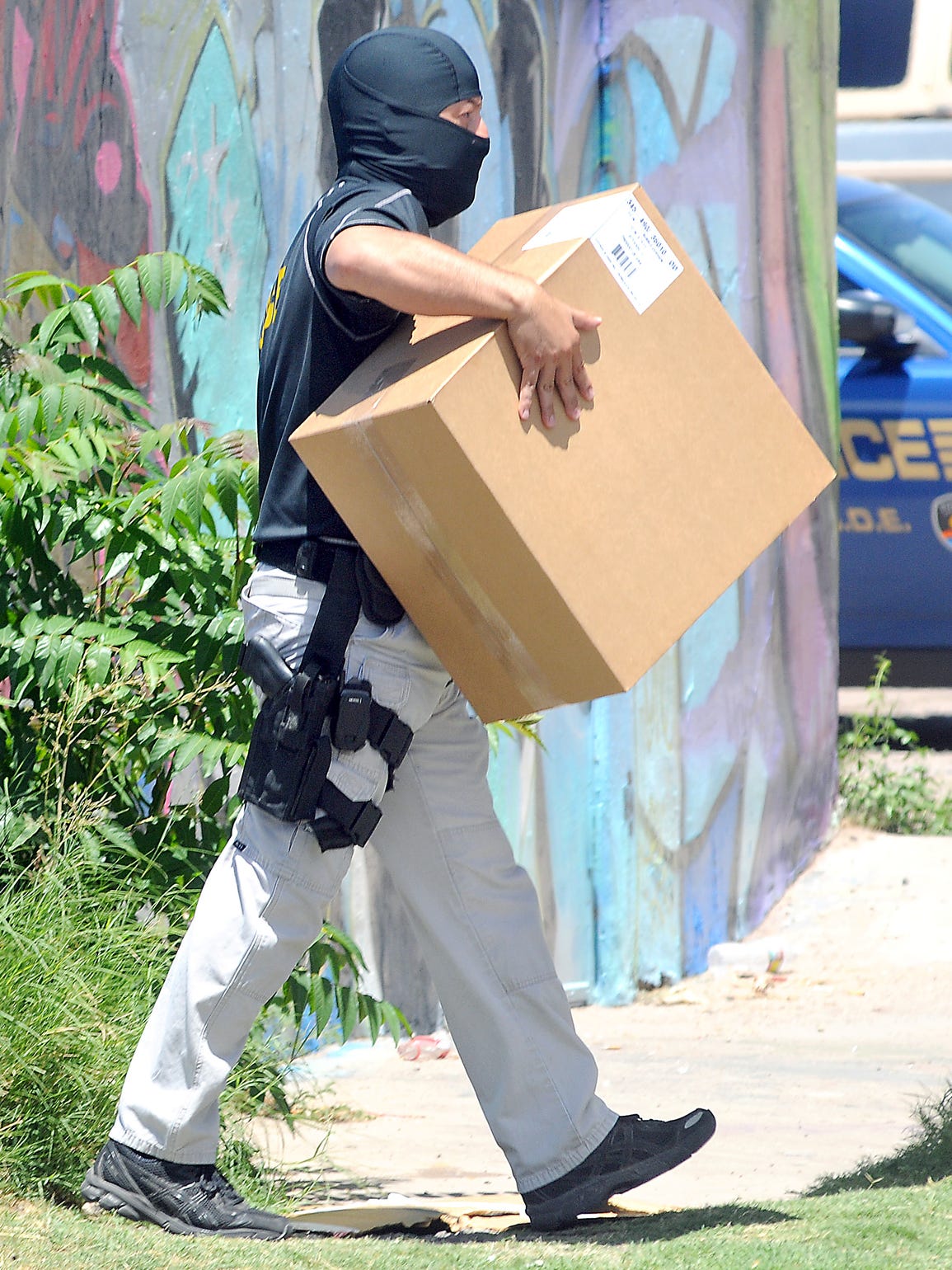
A masked DEA agent carries evidence out of Phat Glass, 1211 E. Idaho Ave., on July 25, 2012, while federal and local law enforcement officers raided 14 area smoke shops as part of a wider investigation into synthetic drug sales.
(Photo: Robin Zielinski / Sun-News)
No city ordinance
At nearly every level, the Spice problem is hard to police and hard to prosecute.
“Because possession up to eight ounces is a misdemeanor offense, the District Attorney’s office does not prosecute the majority of Spice-related cases,” said Patrick Hayes, a spokesman for the Third Judicial District Attorney’s Office. Instead, most possession cases are prosecuted by the arresting officer in Municipal Court.
Locally, there is no ordinance that specifically bans Spice. Instead, officers are forced to prosecute Spice possession under Sec. 19-342 of the municipal code, which was written to target the abuse of inhalants such as glue or paint.
The ordinance states, “No person shall intentionally smell, sniff or inhale the fumes or vapors from a glue, aerosol spray product or other chemical substance for the purpose of causing a condition of or inducing symptoms of intoxication, elation, euphoria, dizziness, excitement, irrational behavior, exhilaration, stupefaction or dulling of the senses, or for the purpose of in any manner changing, distorting or disturbing the audio, visual or mental processes.”
It’s a stretch, but absent a more tailored ordinance, officers must make do.
Chemically similar?
In 2011, the New Mexico Legislature passed SB 134, which adds synthetic cannabinoids to the list of hallucinogenic controlled substances under Schedule I of Controlled Substances Act. But because the list of banned chemical compounds are controlled at the federal level, any significant changes in expanding that list must be done by congress and the Drug Enforcement Agency.
Of more than 450 known synthetic cannabinoids, only 26 are on the DEA’s list of Schedule I narcotics. This also adds to the complexity of prosecuting Spice cases. Before charges can be brought, the Spice must be sent off for chemical analysis at a crime lab to test for illegal compounds.
Last year, a convenience store in Las Vegas, Nevada, was raided, and about 20 pounds of Spice was seized. The Spice was sent off to a crime lab to be tested, and only half a pound tested positive for outlawed chemicals.
To combat this problem, prosecutors often resort to prosecuting Spice cases under theFederal Analogue Act of 1986, and its New Mexico counterpart, Statute 30-31-23 which covers possession, and Statute 30-31-20 for trafficking.
“Spice is constantly evolving,” said Laila Rico, a spokeswoman for the DEA’s El Paso office. “We’re seeing these substances coming from other countries. The government has added a provisions to allow for the prosecution of similar synthetics — the cousins of those chemicals on the banned list, if you will — emerging cannabinoid substances.”
Analogue laws prohibit substances that are “substantially similar” but may not contain the exact chemical compound as controlled substances. These laws allow prosecutors to treat Spice-like products as a prohibited drug, if the analogue drug is “substantially similar in chemical structure and intoxicating (pharmacological) effects as a scheduled controlled substance,” according to the National Conference of State Legislatures.
The problem prosecutors face using analogue laws is that new synthetic cannabinoids are being introduced all the time, and the expert chemists or pharmacologists they may call to testify might have no knowledge or expertise on the compound specific to the case being tried. Furthermore, the defense can call its own expert to argue the chemical structure or pharmacological effects are not similar at all.
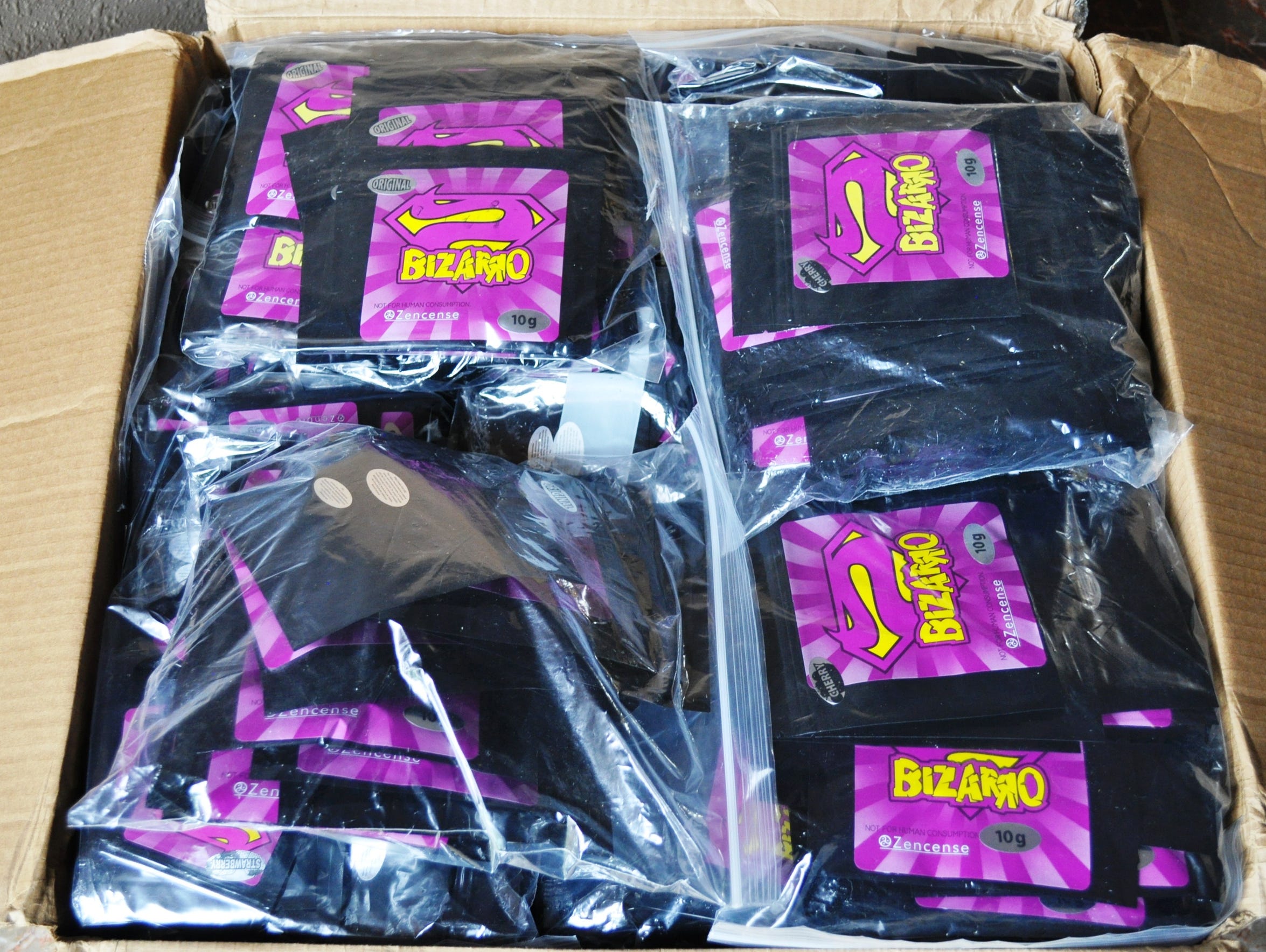
Packets advertising Bizarro contain the drug Spice.
(Photo: Courtesy DEA - El Paso Division)
Exploring solutions
“The first thing we need to do is get a local ordinance, to make it easier for the officers on the streets to prosecute,” Mercer said. “This has to have its own city ordinance. That it doesn’t is totally ridiculous. Then we have to go after the smoke shops, and the people who are selling it.”
Though Spice is illegal, it is still sold in local smoke shops, according to several sources. It isn’t prominently displayed, and sometimes a code word is required to buy it.
“Last year, prosecutors from the District Attorney’s office worked with local police to distribute a pamphlet that lists the penalties associated with selling Spice,” Hayes said. “That way, if businesses get caught selling it, we can prove they knew what they were doing was illegal.”
“We need to stop blaming the victims of these synthetics, and start going after the true perpetrators — which are the businesses that are concocting these formulas that are uncertified by the FDA or USDA,” said David Boje, a professor in New Mexico State University’s College of Business. Boje is an organizer of Veterans’ Theater, a local theater troupe comprised of homeless and once-homeless vets. The group recently performed “Early Christmas,” a play on the dangers of Spice, and its effects on military personnel and the homeless population.
“One way to target businesses is to start revoking the business licenses of the retail establishments, the companies that are mixing the product together, and the chemical importers. There’s a whole network that needs to be targeted," Boje said.
Third Judicial District Attorney Mark D’Antonio said he supports cracking down on the suppliers.
“When you have people dying on the streets and overdosing in the shelter, we need to do something about it,” D’Antonio said. “We know dealers are targeting kids and the less fortunate. So we need to focus on holding the sellers responsible, not just the users. Justice demands no less.”
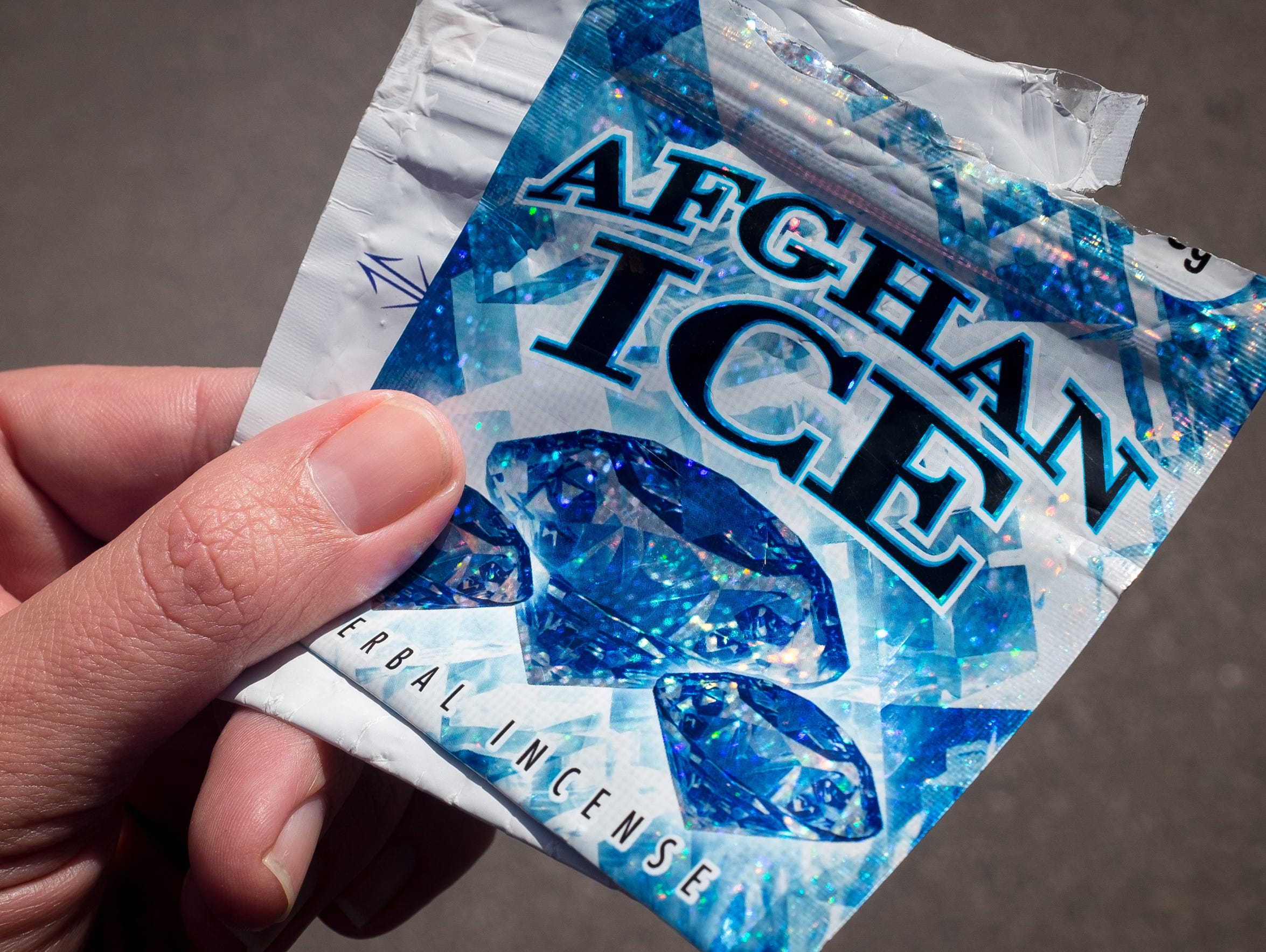
Empty foil packets that contained the drug Spice are found near the Mesilla Valley Community of Hope. The drug is sold as "potpourri" and "herbal incense" in packaging with names such as Afghan Ice and Purple Flake.
(Photo: Jett Loe / Sun-News)
Litigation vs. Education
In the race between lawmakers and chemists, the chemists will always win.
According to a 2011 Bloomberg Business article, synthetic cannabinoids are taking an increasing chunk of the market for recreational drugs, estimated by Jeffrey Miron of Harvard and the Cato Institute to be $121 billion in North America.
With that kind of money at stake, and the ever-present challenges in policing and prosecuting Spice cases, many stakeholders feel efforts are better applied to reducing the demand rather than the supply. And that must start with raising awareness.
“We have noticed that when kids are better informed, they make better decisions,” said Rico, speaking of the DEA’s efforts to educate middle school students. “Kids don’t know what it is made of, where it is coming from, or what is in it. We get calls to speak to middle schools. They don’t really have a grasp on what Spice is.”
Once it is explained to them — the way the chemicals are made, that it’s not at all like marijuana, that it’s not safe or legal, and that it’s dangerously inconsistent — they are much less likely to try it, she said.
“It’s demand-reduction,” Rico said. “In going out and speaking with kids, they’re under the impression that it’s a safer form of marijuana. You really have to take the time to get them to understand how it’s made, where it comes from.”
The DEA has two websites devoted to educating parents and teens about the dangers of Spice.
“JustThinkTwice.com is geared toward kids, to help them understand the real risks involved. For adults, we have GetSmartAboutDrugs.com, a resource for parents and educators where you can find videos on all kinds of drugs that kids might encounter.”
Damien Willis may be reached at 575-541-5468, dawillis@lcsun-news.com or@damienwillis on Twitter.
